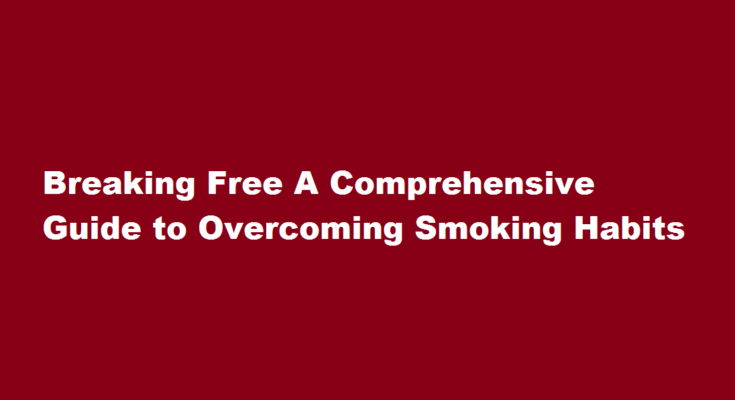Introduction
Smoking is a highly addictive habit that poses severe health risks and affects both smokers and those around them. However, quitting smoking can be challenging due to the addictive nature of nicotine. This article provides a comprehensive guide on how to get rid of smoking habits, offering practical tips, support mechanisms, and valuable insights to empower individuals on their journey to a smoke-free life.
Understanding the Addiction
To effectively overcome smoking habits, it is crucial to understand the addiction and its impact. Nicotine, the primary addictive substance in cigarettes, stimulates the brain’s reward system, making quitting difficult. Nicotine withdrawal symptoms, including irritability, cravings, and anxiety, can further hinder cessation efforts. Recognizing these challenges helps individuals develop a strong mindset and the determination required to overcome them.
Set a Quit Date and Make a Plan
Committing to a quit date provides a clear target and motivates smokers to prepare mentally and physically for the journey ahead. Develop a personalized plan by identifying triggers, finding healthy alternatives, and gathering support. Establishing coping mechanisms, such as engaging in physical activity, practicing deep breathing exercises, or pursuing hobbies, can aid in managing cravings effectively.
Seek Support
Quitting smoking is more manageable with a strong support system. Inform friends, family, and colleagues about your decision to quit and seek their encouragement. Joining a support group, either in person or online, allows you to connect with individuals facing similar challenges, providing a sense of belonging and understanding. Professional assistance, such as counseling or nicotine replacement therapy, can also significantly increase success rates.
Modify Your Environment
Creating a smoke-free environment is crucial to overcoming smoking habits. Remove all smoking paraphernalia from your home, car, and workplace to eliminate visual cues and temptations. Additionally, consider repainting walls, washing curtains, and deep cleaning to remove any lingering odors. Avoid situations or places associated with smoking initially, as these can trigger cravings. Instead, surround yourself with individuals and locations that promote a healthy, smoke-free lifestyle.
Adopt Healthy Lifestyle Changes
Embracing a healthier lifestyle can facilitate the process of quitting smoking. Engage in regular physical activity, as exercise not only distracts from cravings but also releases endorphins, providing a natural mood boost. Focus on consuming a balanced diet, rich in fruits, vegetables, and whole grains, to support your body’s recovery from the damages caused by smoking. Minimize alcohol and caffeine intake, as these substances can trigger cravings. Prioritize self-care activities, such as meditation, yoga, or journaling, to manage stress and promote overall well-being.
Frequently Asked Questions
What is the most popular way of quitting smoking?
Nicotine patch plus lozenge or gum is the most common combination. 1) Using more than one medicine can help a lot. 2) One non-nicotine medicine is especially effective. 3) You can increase your chance of success when using quit- smoking medicine.
What questions to ask to stop smoking?
What are your recent thoughts about quitting smoking? What do you know about smoking and your family’s health? What do you think it would be like to stop smoking? What are your concerns about quitting?
Conclusion
Overcoming smoking habits is undoubtedly challenging, but it is entirely possible with the right mindset, strategies, and support. By setting a quit date, seeking support, modifying the environment, and adopting a healthier lifestyle, individuals can break free from the shackles of smoking. Remember, every journey starts with a single step, and with determination and perseverance, a smoke-free life is within reach.
Read Also : Mastering The Art of Focus Key Strategies for Staying on Track



